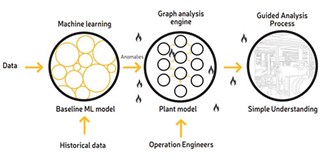Problems in process plants can be loosely categorized into two main types: predefined or repeating problems, and undefined or non-repeating ones. While both types cause loss of income and unnecessary outlay, undefined problems have a far greater impact on revenue and productivity.
Let’s look at how each type fits into the rubric of predictive analytics, and how Precognize’s SAM GUARD can predict and prevent both types of problems, generating clear return on investment. Our core competence is in identifying and solving the undefined, non-repeating problems, however SAM GUARD of course also has a solution for the defined problems, which are actually much easier to deal with.
Defined problems
Predefined, repeating problems are when the problem is known. It’s something that has happened before and repeats fairly often. Repeating problems are common around process improvement, like aiming to maintain the golden batch. Engineers can use Precognize’s SANDBOX to find out which tags are relevant for that problem, to spot the causes of the problem and find the parameters and monitor them if relevant. The SANDBOX can connect between seemingly unrelated parameters, identifying the root cause. A bigger challenge lies in alerting plant engineers to non-repeating, undefined problems that arise Predicting defined and undefined problems in process plants seemingly out of nowhere, because there’s no historical data to prepare you for such events.
Undefined, non-repeating problems
Undefined problems are ones that do not repeat themselves, like most cases in the process industry. In these cases, the issue never occurs in the same place or in the same way twice, making it unexpected. Examples of undefined problems include equipment failures, small process deviations, and changes to the operating process because of equipment failure, malfunction, or abnormality. In process plants, non-repeating problems occur more often than repeating problems, but they remain harder for most solutions to predict and analyze. Here are several examples of non-repeating problems, and how SAM GUARD identified them and created new value for the plants:
Petrochemical example: partial blockage in heat exchanger
At a petrochemical plant, SAM GUARD alerted due to substantial differences in temperature, combined with multiple parameters measured in the heat exchanger and other related parts of the plant. All of the measurements showed an accelerated fouling process, indicating a partial blockage in the heat exchanger which was the operational root cause. As a result of this combined alert, the heat exchanger was cleaned, and the partial blockage was removed. It was determined that while the heat exchanger had been partially blocked it had led to higher energy costs and increased fluid velocity, causing potential erosion problems; if it had not been fixed in time, it would have eventually led to a plant shutdown and lost production.




